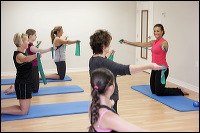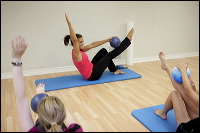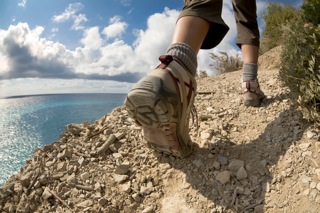Greetings
The first hints of Fall are here and it's a time when many people think about getting back to work, school, and a more active and healthy routine.
Being active is not only fun - it is a key part of healthy aging. Our lead article in this newsletter is focused on "Healthy aging through staying active."


Pilates is a great way to get active, tone and strengthen the core muscles, recover from injury and get the recommended level of lean muscle building activity.
If you are new to Pilates and interested in giving it a try, or would like to ramp up your existing routine, now is a good time to start. Please see our Pilates Class Schedule beginning September 12th. Our classes are small in size, and suitable for men, teens, older people and athletes interested in improving their performance. If you have an existing injury or chronic issue (ie. back or neck pain, headaches) and would like to use your Physiotherapy benefits to cover the cost of classes or individual sessions a Dr.'s referral may be required by your insurance. A Clinical Pilates Physiotherapy assessment and one on one appointments to understand the basic principles are also recommended. The classes are getting busy so please make sure you sign up in advance!
With the change of seasons also comes a change to our staff. Unfortunately we are saying goodbye to Physiotherapist Jenna Peters. Jenna is moving to Victoria BC at the end of September. We wish her all the best and will miss her. If you are a client of Jenna's or have enjoyed her classes we are in the process of recruiting a Clinical Pilates trained Physiotherapist. In the meantime, Kubet and Cheryl look forward to assisting in your care. Also, there have been some changes to our Administrative team. Nicole had a beautiful baby girl in July and is on maternity leave. This week we welcome Carolyn who has a wealth of experience in Rehabilitation medical clinics.
Wishing you good health in the season ahead,
All the best! The Skye Physio team
We have recently added over 40 new articles to our patient resource library including the following (click on the links to view them) :
New Content Sections:
New Patient Guides:
Featured Article:
Staying Active is the Key to Healthy Aging

Our bodies change dramatically as we age. We lose muscle tone and tend to gain more weight. Many people also experience bone loss, fragility and deteriorating cardiovascular health and stamina as they get older, especially if they don't exercise. In fact, studies have shown that without regular physical activity, you can lose 30-40% of your muscle mass by age 70 [1,2]. Now that's a scary thought.
The good news, though, is that this frightening picture of aging doesn't have to come to pass. There are ways to slow and even reverse the negative physical effects of aging so you can stay strong, fit and healthy throughout your golden years. With the guidance of a trained physiotherapist, you can learn what will work best for you and your body so you can keep yourself healthy for years to come.
Combating Common Ailments Caused by Aging
Lower Back Pain – Strength training can readily decrease back problems or alleviate lower back pain altogether. Doing exercises like weight training, exercise with resistance bands and body weight exercises like push-ups and squats regularly can also help lubricate the joints and strengthen muscles throughout the body, which is why the American College of Sports Medicine recommends strength training twice weekly to maintain health [3]. Since the back is part of our body’s core, strengthening all of the back muscles will help align everything correctly. Stretching and maintaining flexibility can also help people suffering from back pain. Regular stretching exercises coupled with the strength training of muscles have been shown in studies to increase flexibility and decrease pain [4,5].
Osteoporosis and Fractures – As you enter your 40s and 50s more of your bone is broken down by your body than is replaced. Over time, this bone loss can reach the point where the bones in your hips, back and wrist break easily, a condition known as osteoporosis [6]. However, severe bone loss isn't inevitable. With the correct exercise regimen advised by your physiotherapist, you can make your bones stronger and possibly even reduce your risk for a fracture [7]. Resistance exercise using light weights or exercise machines will increase bone density throughout the body, enhance muscle mass and strength and preserve bone calcium. Weight-bearing exercises like walking or climbing stairs are also great ways to strengthen your bones.
Cardiovascular Decline – Increasing age is also linked to diminishing aerobic capacity. While a healthy 25-year-old heart can pump 2.5 quarts of oxygen a minute, a 65-year-old heart can’t pump more than 1.5 quarts, and an 80-year-old heart can only reach about a quart, even if it’s completely healthy. This can cause fatigue and breathlessness even during normal daily activities [8]. The best way to improve your cardiovascular function is with endurance exercise. Activities like walking and aquatherapy will help keep your heart muscle strong and your arteries flexible, boosting your heart's ability to deliver oxygen-rich blood throughout your body. Your physiotherapist will be able to recommend activities that will be safe and effective for you.
Injuries – It seems obvious that the less you use your muscles the weaker and more fragile your body will become, yet many people become less active as they age. Unfortunately, inactivity leading to loss of muscle mass in the body is one of the biggest cases of injuries in aging people [9,10]. A physiotherapist will be able to devise a personalized exercise plan that can help you establish better balance and agility, increase your flexibility, create stronger muscles and increase bone density, all of which will help you move more easily, prevent falls and aid in preventing injuries [11]. If you are already recovering from an injury, an exercise schedule advised by your physiotherapist can help you heal faster and strengthen your body so you can avoid future injuries.
Starting a program that is as simple as 30 minutes of walking almost every day will produce major benefits in your health as you age. But adding things like strength, balance and flexibility training will help even more. Talking to a physiotherapist is one of the easiest ways to create a training regimen that is tailored to your body, your lifestyle and your health-related goals. By working together, you can establish a routine that will make aging less stressful and much more enjoyable.
References
1. Grimby G, Saltin B. The aging muscle. Clin Physiol. 1983;3:209-218.
2. Israel S. Age-related changes in strength and special groups. In: Strength and Power in Sport. PV Komi, ed. Boston, MA: Blackwell Scientific, 1991.
3. Haggman T, Eriksson E, Jansson E. Muscle fiber type changes in human
4. skeletal muscle after injuries and immobilization. Orthopedics 1986;9:181-185.
5. Kent-Braun JA. Specific strength and voluntary muscle activation in young and
6. elderly women and men. J Appl Physiol. 1999;87(1):22-29.
7. Mazzeo RS, Cavanagh P, Evans WJ, et al. Exercise and physical activity for older adults. Position stand for the American College of Sports Medicine. Med Sci Sports Exerc. 2009;30(6):992-1008.
8. McComas AJ. Skeletal muscle: Form and function. 2nd Edition. Champaign, IL:
9. Human Kinetics, 2005.
10. Nelson ME, et al. Effects of high-intensity strength training on multiple risk factors for osteoporotic fractures. JAMA. 1994;272:1909-14.
11. Adams K, O’Shea P, O’Shea KL. Aging: Its effects on strength, power, flexibility, and bone density. Nat Strength and Cond Assoc. 1999;21(2):65-77.